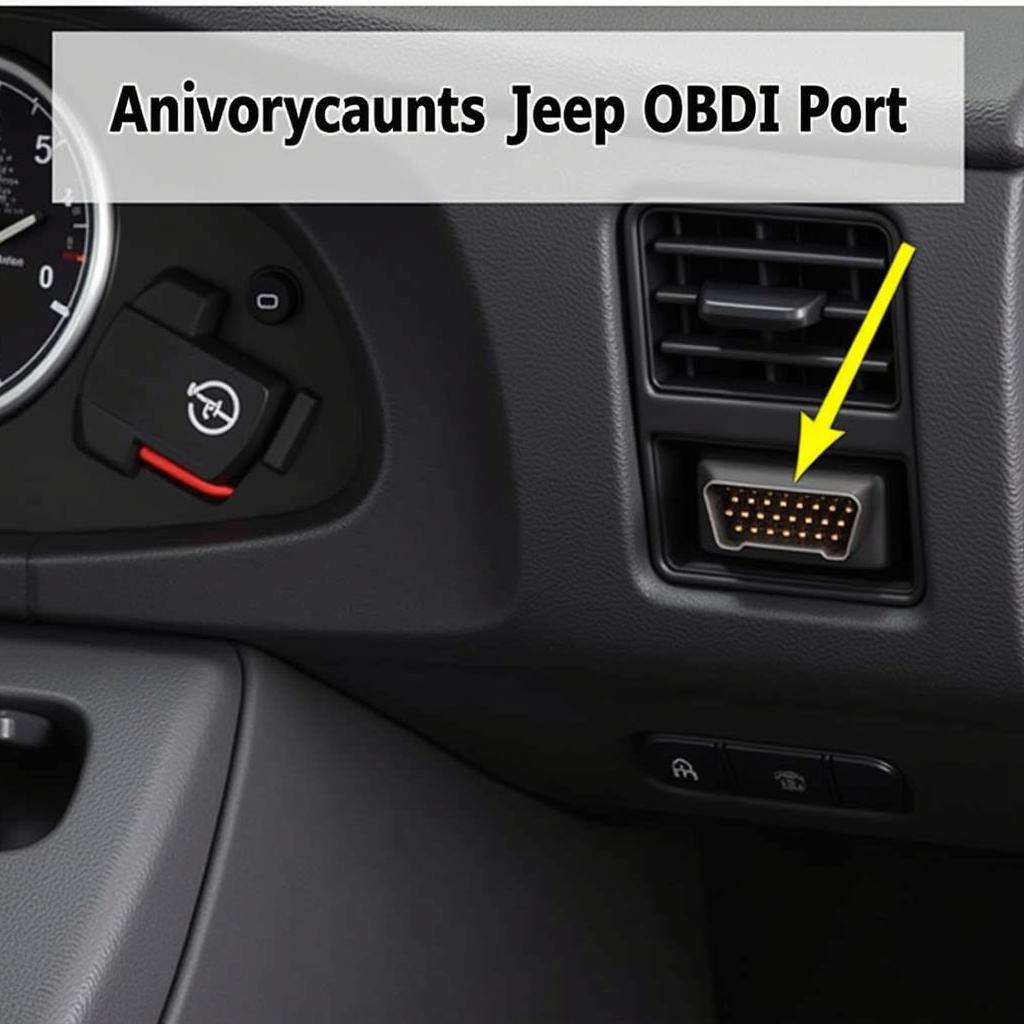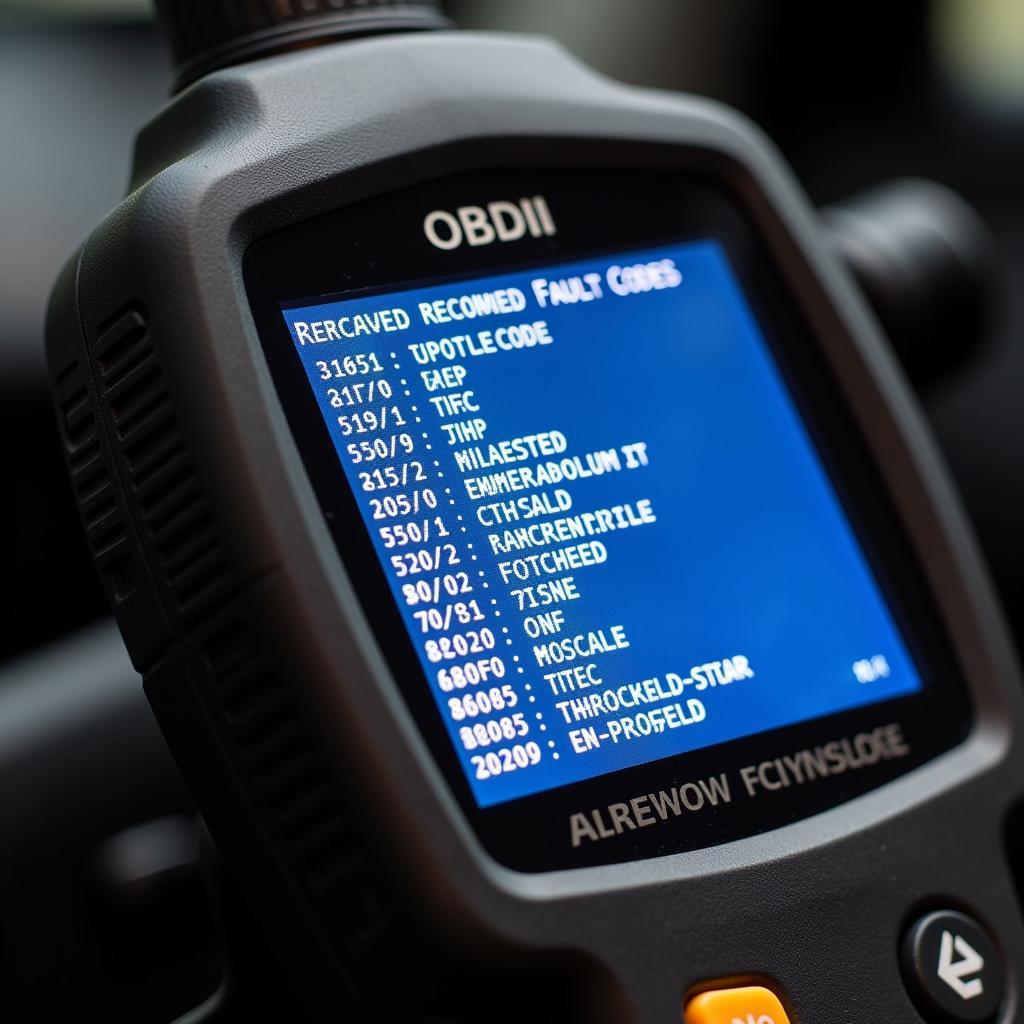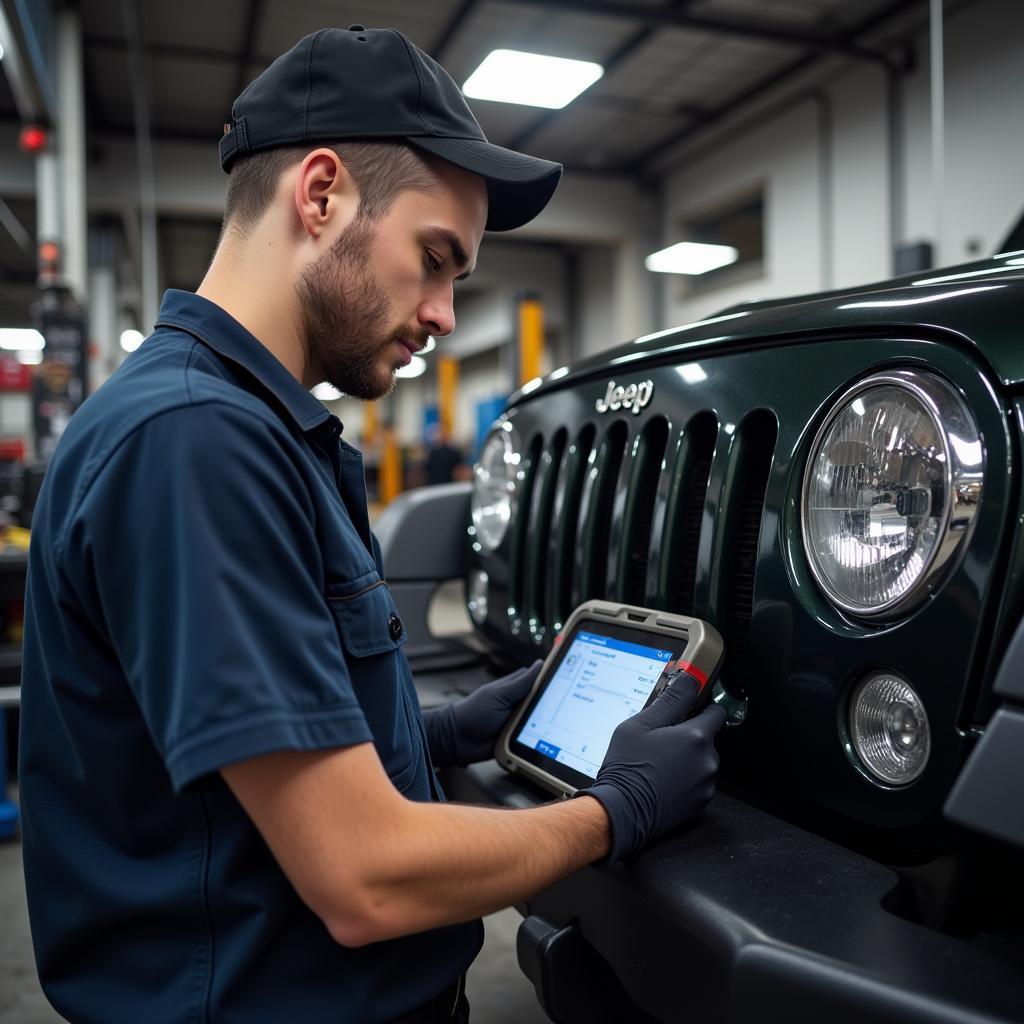Troubleshooting those pesky dashboard warning lights on your Jeep just got easier. An OBDII scan tool is a must-have for any Jeep owner or mechanic, allowing you to read and clear fault codes that trigger those frustrating “check engine” lights. This guide will walk you through the process of understanding and clearing Jeep fault codes using an OBDII scan tool, empowering you to take control of your vehicle’s diagnostics.
Understanding Jeep Fault Codes and Your OBDII Scanner
Your Jeep’s onboard computer system, also known as the Engine Control Unit (ECU), continuously monitors various sensors and systems in your vehicle. When a malfunction is detected, the ECU generates a fault code and often illuminates a warning light on your dashboard.
An OBDII scan tool acts as the bridge between you and your Jeep’s ECU. By plugging the scan tool into your vehicle’s OBDII port (usually located under the driver’s side dashboard), you can access these stored fault codes. Each code corresponds to a specific issue, providing you with valuable insights into the potential root cause of the problem.
 jeep obdii port location
jeep obdii port location
Steps to Clear Jeep Fault Codes Using an OBDII Scan Tool
Before you begin, make sure you have a compatible OBDII scan tool for your Jeep model.
-
Locate Your Jeep’s OBDII Port: As mentioned earlier, the OBDII port is usually situated under the driver’s side dashboard.
-
Connect the OBDII Scan Tool: Turn off your Jeep’s ignition and connect the scan tool to the OBDII port.
-
Turn On the Ignition: Turn the ignition key to the “on” position but don’t start the engine.
-
Power Up the Scan Tool: Switch on your OBDII scan tool. It might take a few seconds to establish a connection with your Jeep’s ECU.
-
Select “Read Codes”: Navigate through the scan tool’s menu and select the option to “read codes” or “retrieve fault codes.”
Expert Insight from John Miller, ASE Certified Master Technician: “It’s crucial to note down the specific fault codes displayed on the scan tool. These codes are vital for researching the problem and understanding its potential severity.”
-
Record the Fault Codes: Jot down the exact alphanumeric codes displayed on the scan tool’s screen.
-
Research the Codes: You can typically find detailed information about Jeep fault codes in your owner’s manual, online repair databases, or Jeep forum communities. Understanding what each code represents helps determine if it’s a minor glitch or a significant issue requiring immediate attention.
 jeep fault codes list on obdii scanner
jeep fault codes list on obdii scanner -
Clear the Fault Codes: After researching the codes and potentially addressing the underlying issues, you can proceed to clear them. Return to the scan tool’s menu and choose the option to “clear codes,” “erase codes,” or “reset ECU.”
-
Confirm Code Clearance: The scan tool will confirm if the codes have been successfully cleared. It’s essential to understand that clearing the codes doesn’t magically fix the problem; it merely erases the codes from the ECU’s memory and turns off the warning light. If the underlying issue persists, the code will likely reappear.
-
Disconnect and Test Drive: Switch off the scan tool, disconnect it from the OBDII port, and start your Jeep. Take it for a test drive to observe if the warning lights resurface.
Expert Insight from Sarah Thompson, Automotive Electronics Specialist: “If the fault codes reappear after clearing them, it signifies a persistent problem that needs professional diagnosis and repair. Attempting DIY fixes without proper knowledge can sometimes worsen the situation.”
Common Jeep Fault Codes and Their Meanings
Here are some frequently encountered Jeep fault codes:
-
P0420 Catalyst System Efficiency Below Threshold (Bank 1): This code usually indicates a problem with your Jeep’s catalytic converter.
-
P0300 Random/Multiple Cylinder Misfire Detected: A cylinder misfire can be caused by various factors such as faulty spark plugs, ignition coils, or fuel injectors.
-
P0171 System Too Lean (Bank 1): This code points towards a lean fuel-air mixture, often caused by vacuum leaks, a malfunctioning mass airflow sensor, or a faulty oxygen sensor.
-
P0442 Evaporative Emission Control System Leak Detected (Small Leak): This code typically indicates a minor leak in your Jeep’s evaporative emissions system, such as a loose gas cap or a small crack in a hose.
-
P0138 O2 Sensor Circuit High Voltage (Bank 1, Sensor 2): This code signals a problem with the downstream oxygen sensor on Bank 1, which monitors the efficiency of the catalytic converter.
Remember that this is not an exhaustive list. Always refer to a reliable source for accurate information about your specific Jeep fault codes.
When to Seek Professional Help
While clearing fault codes with an OBDII scan tool might seem straightforward, there are instances when professional help is essential.
- Recurring Fault Codes: If a fault code reappears shortly after you’ve cleared it, it indicates a persistent problem requiring professional diagnosis.
- Complex Issues: Certain fault codes might point toward intricate mechanical or electrical problems that are best handled by experienced mechanics.
- Lack of Expertise: If you’re unsure about the meaning of a fault code or uncomfortable performing any repairs yourself, don’t hesitate to seek assistance from a qualified mechanic.
 mechanic diagnosing jeep with scan tool
mechanic diagnosing jeep with scan tool
Conclusion
Learning how to clear Jeep fault codes with an OBDII scan tool is a valuable skill for any Jeep enthusiast. It empowers you to gain a better understanding of your vehicle’s health and address minor issues before they escalate. However, always remember that safety should be your top priority.
If you’re unsure about any aspect of diagnosing or repairing your Jeep, don’t hesitate to reach out to the experts at ScanToolUS. We’re here to assist you with all your automotive diagnostic needs. Contact us at +1 (641) 206-8880 or visit our office at 1615 S Laramie Ave, Cicero, IL 60804, USA.

